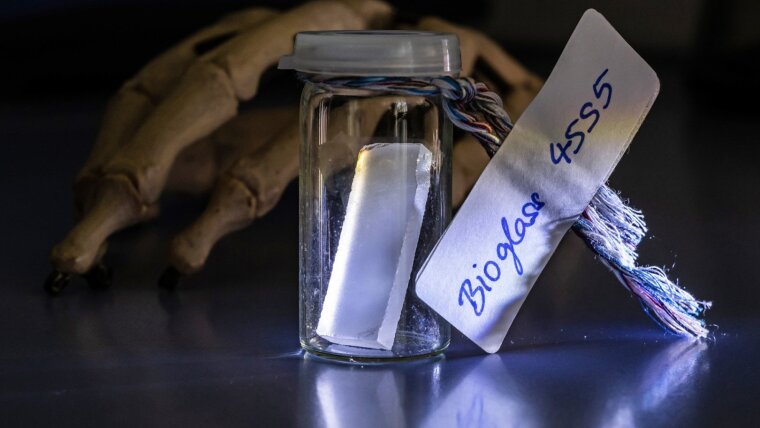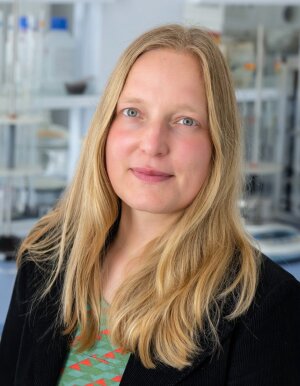
After many cycles in the dishwasher, our drinking glasses often appear cloudy. This is usually not caused by limescale deposits but by corrosion. Contact with water and cleaning agents – and the associated chemical and physical processes – roughen the material’s surface and alter its structure. Put simply, the glass begins to dissolve. As irritating as this process may be when it comes to household items, it is interesting for other uses of glass – even in the human body.
By Sebastian Hollstein
Glass is usually made of silicates. But if pure silicon dioxide were used in its production, processing would only be possible at very high temperatures, making it very difficult. That is why metal oxides such as calcium or sodium oxide are integrated into the silicate network. This facilitates the production process – but reduces durability because the resulting glass reacts more rapidly with water.
The increased solubility isn’t necessarily a disadvantage. For example, for around 50 years scientists have been working on compositions referred to as »bioactive glasses«, developing applications for them in the medical field, such as for repairing damaged bone. At the time, glass was the first synthetic material that could form an integrated bond to human tissue.
Prof. Dr Delia Brauer and her team are developing, among other things, soluble glass implants that help to regenerate bone after an operation.
Image: Jens Meyer (University of Jena)Natural bone cells grow on glass implants
»When body fluids react with bioactive glass, calcium and phosphate ions are released«, explains Prof. Dr Delia Brauer, who is a professor for this special material at the Friedrich Schiller University Jena and one of the world’s most renowned experts in the field.
»During this chemical process the glass surface gets covered with a calcium phosphate layer. This calcium phosphate mineral, apatite, is also the inorganic component of our bones. Bone cells attach to this layer and form new bone tissue«.
All substances that make up the glass naturally occur in the human body, and the apatite surface in particular ensures that the glass is not rejected as a foreign material. In addition, dissolved silicate species further promote the healing process by stimulating bone formation.
Once the implants have performed their function, they are gradually broken down until they have completely disappeared. The exact duration of this process can be adjusted via the glass composition.
Degradable glass implants are mainly used when bone defects need support during healing, such as after removal of a tumour or a cyst. Doctors usually insert the glass into the bone defect in the form of granules or gel.
Brauer and her team are currently optimizing the design and mechanical structure of porous three-dimensional scaffolds which are intended to guide the bone cells during bone tissue formation.
»Glass is probably not the first material that comes to mind when we think about regenerating human tissue – and yet its variable composition makes it extremely suitable for this purpose«, says the chemist. »That’s what makes it so exciting«. Although the use of bioactive glasses as implants has now become established, Brauer and her team are constantly looking for new ways to optimize their application.
Compared to other implant materials such as ceramics, the advantage of glass is that further components can be added with a high degree of flexibility. For example, silver ions can be integrated into the glass to give implants antibacterial qualities that prevent inflammation and eliminate the need for antibiotics.
Oral hygiene with glass
Apart from bones, bioactive glass also is used in oral applications. For example, Delia Brauer has helped to develop a toothpaste that contains bioglass particles. These particles adhere to the tooth surface and are not washed away during rinsing. When they come into contact with saliva, they release calcium, fluoride and phosphate ions, stimulating the formation of apatite – which is also the main component of tooth enamel.
Jena’s glass expert was recently approached by a team of researchers from King’s College London. »After discovering that lithium ions promoted the formation of dentine, our English colleagues were looking for an effective and targeted method of introducing lithium so that it could be released in a controlled and continuous manner«, says Brauer. »Together we developed a now patented cement system based on lithium-containing bioglass«.
In addition to such applied material developments, Delia Brauer’s research is mainly centred around gaining a better understanding of bioactive glass and its processing. After all, many questions are yet to be answered. »As bioactive glasses start to crystallize faster than other glasses during melting, this limits the processing options«, she says.
For this reason, she is currently observing the crystallization process at nanometre level in cooperation with researchers from the University of Erlangen-Nuremberg and the Fraunhofer Institute for Microstructure of Materials and Systems in Halle (Saale). The scientists hope to develop their understanding of the process and ultimately avoid it. This basic research will pave the way for bioglass to be used in many other fields.
